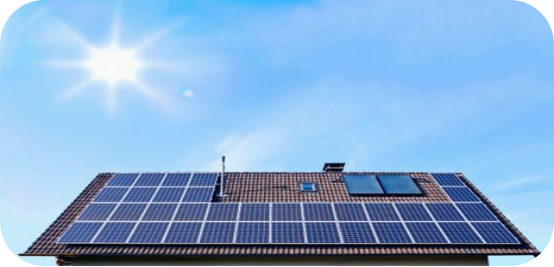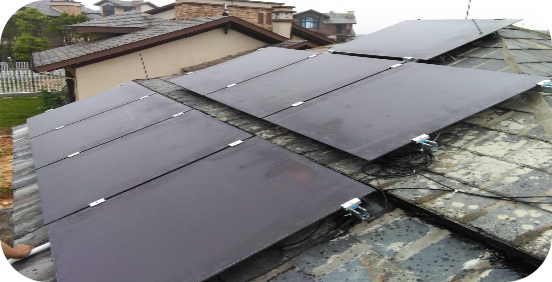
1.Components and Parts of Solar Photovoltaic Equipment
The complete unit of solar photovoltaic equipment comprises of solar battery module, bracket system, inverter, electrical distribution system and so forth, which can be installed and debugged just within 1-3 days and no alteration to the original household wire will be made. Significantly, the solar photovoltaic equipment is able to be served for as long as 25 years.

2. What does It Take to Install the Solar Photovoltaic Equipment?
The installation of solar photovoltaic equipment is simple and just available as long as the house has uncovered flat or slop or external wall. Moreover, the installation is harmless to the roof and waterproof.
3. Is the Roof Distributed PV System Safe Without Risk of Illegal Installation?
The distributed PV system has seen speedy development for several years with quite advanced or mature market experience. Both the design and the technology are safe and reasonable, while custom-made installation solution will be designed tailored to the housing surroundings, with no need to reconstruct the house structure. The distributed photovoltaic could be applied into a variety of house roofs, including the concrete roof, pitched glazed tile roof of villas and the colored steel tile roof of factories.
As governments have been issued many supporting papers and policies, there is no risk of photovoltaic system installation.
4. How Much Will It Cost?
In accordance with the installation power, generally it takes about ¥10,000/KW. For the generation power of each solar photovoltaic equipment in rural areas is within 3KW-5KW, so it costs about ¥30,000-5,0000.
5. Is It Affordable and Economical?
Residents can benefit from the electricity saving and government subsidies. Regarding the purchase of photovoltaic power of a premium PV power system, the cost of main materials accounts for 70% of the total while the installation for 10% and the rest for operation expenditure. As for the rural residents, the national governments have put forward an array of policies including loan, and photovoltaic poverty alleviation. In the near future, each household is able to afford the photovoltaic power.

6. How about the Service Life and Post-Sale Maintenance?
A set of photovoltaic power system can work as long as more than 25 years. Generally speaking, a premium system integrator purchasing the qualified products can be free from the additional post-sale maintenance cost. The majority of brand enterprises render a limited power quality warranty for photovoltaic modules.
Considering the resistance to natural disaster, made-in-China photovoltaic power system is a good choice. In 2016, Typhoon Nida, the strongest cyclone hit the Pearl River Delta. Incredibly, none of power plants was out of order, instead all of them were in common daily operation. It turns out that the resistance capability to natural disaster is strong for the photovoltaic power plants.
7. What If National Subsidy Being Abolished?
The national governments has adopted the individual household subsidy model of ¥0.42/degree for 20 years. If the subsidy canceled one day, the power plants that built before will not be affected, and for those built later the policy are not available to get the subsidy.
All in all, during current golden period of photovoltaic power, the distributed photovoltaic power has promising outlook. An increasing number of photovoltaic power system are brought into people’s daily life, and they will indeed experience the enormous change with photovoltaic power.
8. Will It Waste a Lot of Energy When Producing Photovoltaic Battery Module?
Needless to say, there must be some energy wasted during the manufacturing process. But think about that, in the next 20 years, the photovoltaic battery module can serve and generate energy consistently. So we should evaluate the consumption of photovolatic battery in terms of its serve life.
9. Will It be the Leading Energy?
It is reported by the International Energy Agency that 4% of global desserts have installed photovoltaic power system, catering to global energy. Photovoltaic power boasts an expansive development space that could be applied into roof, building coverage and raw space, dessert, etc. with unpredictable potential. Statistically, the market potential of installed distributed photovoltaic of China’s existing housing roof exceeds more than 300 million KW. When estimated in addition to the west China market, billions of KW will be achieved. Owing to the technical progress and scale utilization of photovoltaic power, the production cost of photovoltaic power will be accordingly reduced and become a more competitive energy supply channel. To some extent, it will transform into the sustainable energy nor the complementary one, being the leading energy in future.
Based in Guangzhou, one of the most promising citiees to develop the photovoltaic market, the 9th Guangzhou International Solar Photovoltaic Exhibition 2017 (PV Guangzhou 2017) is scheduled to render every insider a unique trade platform. Backed by its experienced exhibition arrangement and a wealth of industry resources, PV Guangzhou 2017 is bound to make a difference to the industry.

For more info, stay tuned to : http://www.pvguangzhou.com/index.php?lang=en
PV Guangzhou Organizing Committee
Contact Person: Ms. Mandy Tsang
Mobile/Whatsapp/Wechat: (+86) 159 1877 5956
Phone: +86 20 2903 7372 Fax: +86 20 82579220
E-mail: mandyt_1@163.com ; grand.ev@grahw.com
Website: http://www.pvguangzhou.com
Twitter: @pvguangzhou


